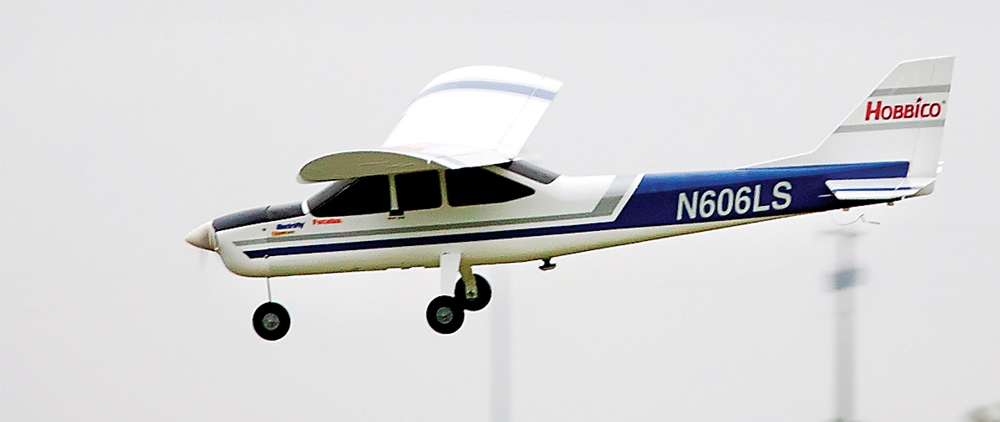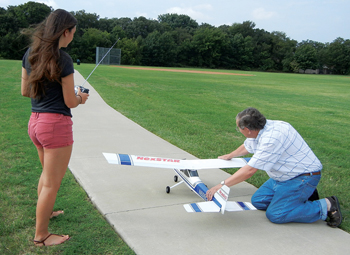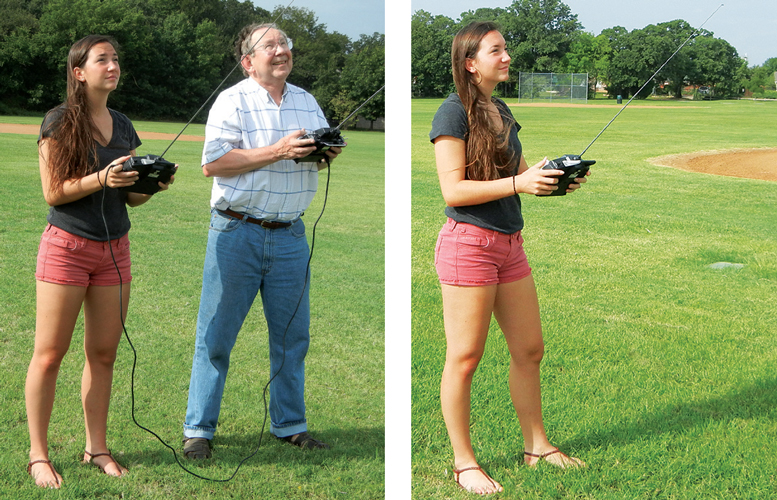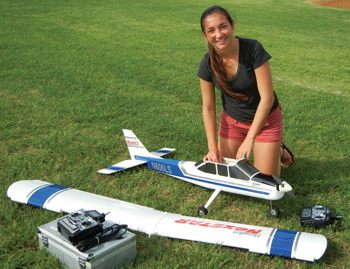
By Tom Atwood With Bob Wilder

In this issue, guest columnist Bob Wilder,a longstanding RC modeler, briefly describes his rich background in RC and his rewarding experience teaching his granddaughter, Dana Wilder, to fly RC airplanes. Then he outlines the basics like only a real RC pro can. Dana first mastered flying models in repeated sessions on a computer flying the original version of the Great Planes Electrifly Nexstar trainer using the RealFlight simulator. Bob’s notes, “Recently I celebrated my 75th birthday with many members of our family and friends. One of our granddaughters, Dana, asked if I would teach her how to fly RC models. Naturally, I was very pleased with this request. Dana is a very smart, talented and beautiful teenager. Currently she is a senior at Ursuline Academy, a Catholic high school for girls.
Long ago, about 60 years ago, I was trying to become more knowledgeable about the model airplane hobby. Fortunately, I had, without a doubt, one of the best model builders of that time to help me. Herbert Davis and I built and flew models together in Birmingham, Alabama. We loved to compete in many model contests. In fact, we went together, in 1953, to the Nationals at Willow Grove, Pennsylvania. I competed with free flight models and Herbert set many records with his u-control (ask Control Line) speed models. My first RC model was a Howard DeBolt “Live Wire”. It had a Lorenze receiver and an escapement that Herbert helped me build. An escapement was used to move the surfaces on a model, much as the servo does today. The power for the escapement was derived from winding a rubber band. It was activated from power in a magnetic coil.
When my friend, Tom Atwood, asked me to help with an article about learning to fly models, I was flattered. Tom informed me that I would soon receive a model from Great Planes. And a few days later, the Nexstar arrived. Obviously, a lot of good design for a trainer went into this model. It even included a Real-Flight software pack and a Futaba transmitter that could directly fly the Nexstar in the Great Planes RealFlight RC simulator. This airplane was equipped with a Futaba receiver and Futaba servos. This early version of the Nexstar (a new version with a 2.4Ghz radio is now available) had a Futaba PA2 pilot-assist-link for a horizontal stabilizer assist. Another very nice feature of this model is training speed brake flaps. Each flap is simple to install or to remove, using only three screws. Nexstar has all of the standard flight controls: elevator, rudder and ailerons. A model with a tricycle gear (a “trike”) is a good configuration for a trainer for a first-time pilot. It might be helpful with landing and take-off (many find this type of airplane easier to take off and land than a tail dragger style).

After mastering the Nexstar in RealFlight, Dana had no problems taking off, flying circuits and landing the Nexstar at the local field. The photos tell the story. Dana was thrilled to become an RC pilot, and her words underscore the fun of learning to fly RC models: “These airplane models are something to be cherished and cared for by those who know every part and trick of the plane, and I’m more than happy to be sharing this wonderful experience with my Granddad! Thank you, Fly RC, for giving us the opportunity to make these amazing memories!”

WING LOADING: An important consideration when choosing a trainer aircraft is the wing loading of the airplane. For example, if the model has one square foot of wing area and the model weighs three ounces., it would have a wing loading of 3 oz./sq. ft., and that would be considered a light wing loading. Normally, a model with a light wing loading will fly at a slower speed than a model with a high wing loading. For a first-time pilot to fly, it would be best to start with a slower air speed.
STABILITY: A model with good stable tendencies is recommended. Normally, a model with a high wing and a small amount of dihedral will be more stable and forgiving.
POWER: There are a few types of power for model airplanes. The most popular types for RC models are electric power and “glow fuel” engine-powered models (glow engines are powered by an alcohol and nitromethane fuel mix). Gas engines are another popular power source. When making a choice for your model, you will find that there are pros and cons for each type of power.
Glow and gas-powered motors have been very popular for over 75 or 80 years, maybe more. They came in many different sizes. The size is referred to as displacement. These days, most model engines are imported. Generally, engine-powered models make more noise and this can restrict the locations where you can fly the model. In the early days, it was not unusual for glow engines to be hard to start. But now, the quality and design of these engines is much improved and they are more reliable. Electric motors are also available in different sizes and they make very little noise. They are easy to start and are the main power for small “park flyer” models. Simply charge the battery and go fly.
Electric-powered models began showing up about 25 or 30 years ago and have been increasing in performance and popularity for years. Some may argue that the gas models are lighter than battery-powered models. Some would debate that and say the opposite. In any event, glow, gas and battery-powered models are all still very popular ways to power an RC model today, with electric power taking an ever growing share of the market.
CHOOSING A MODEL: When selecting your model, the size of your budget will be a big factor to take into consideration. For your first model, I would suggest you consider a model in the lower price range. Keep in mind that most models do not include many of the items that you will need in order to fly your model. However, in many cases, you can select an electric-powered model that is labeled “ARF” (Almost Ready-to-Fly). This generally means that it comes with a transmitter, battery, and battery charger. Also, if you select an ARF model, there is no requirement to build anything. There may be a little assembly required but, generally, that will be easy and require less than one hour. An ARF model’s price range might start at about $100 and a big ARF model could be priced above $1,000. If the electric RC model sounds good to you, I suggest you begin in the $100 to $200 price range. This range will be for a smaller model.
Generally speaking, if you crash a small, light-weight model, often (but not always) there is little or no damage. Most of the parts of this type model can be purchased separately at your local hobby shop. Make sure that you ask your dealer about this before you make your purchase. Before selecting a model, you should ask two or three experienced modelers for suggestions. The same thing is true when you start to fly for the first time. Most experienced modelers will be glad to help. Should you choose a glow or gas-powered RC model, that would normally mean that you would purchase the engine separately. Also, in many cases, you would need to purchase the radio equipment separately. Modelers that fly gas-powered models seem to enjoy the sound of brute power.
JOIN THE AMA AND A CLUB: Many cities have local model airplane clubs. Sometimes those clubs have a favorite flying site. I suggest that you consider joining one of these clubs. Also, check out this AMA web site: www.modelaircraft.org.
TYPES OF FLYING: Don’t assume that you need to be able to do all the fancy maneuvers you see experienced modelers do on your first day. Just take off, fly normally, and land. You should practice, practice, practice normal conservative flying many times. Make sure you have an experienced pilot with you. In fact, your instructor can start your motor for your first flight. I would suggest you use a buddy trainer cable for your first flight.
Before you choose an electric, glow or gas model, while at your local hobby shop, inquire about using their RealFlight simulator. Most hobby shops will let you use their simulator in the shop at no charge. Flying different simulator models will help you decide on the model of your choice.
INDOOR RC: Flying RC models in a large arena such as a basketball court might appeal to you. Flying indoors means electric models only. There are several advantages in flying indoor models. Perhaps the biggest advantage is that the weather is predictable!
There are many small, lightweight electric models to select from. Many of the indoor electric models available at your local hobby shop are ARF models. However, you may like the idea of building your own airplane. There are a few indoor RC kits available to build. If your hobby shop does not have indoor RC kits, check the internet. But please remember that whether your choice is an electric or an engine-powered model, the bottom line is that you should patronize and support your local hobby shop first, if you can.
CONTACTS
ELECTRIFLY electrifly.com, (217) 398-3630
GREAT PLANES greatplanes.com, (217) 398-3630
REALFLIGHT realflight.com, (217) 398-3630
 Fly RC Magazine WE LIVE RC
Fly RC Magazine WE LIVE RC
